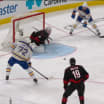"It's an amazing place, a huge part of hockey history and it probably housed some of the best teams and some of the best players that ever played the game. It's a very special place, I spent close to nine years here, the core of my career, and what I was built into as a player, on the ice, a lot of it was here and due to a lot of people from here." -- former Edmonton Oilers captain Doug Weight
EDMONTON -- For years, an office door in the Edmonton Oilers dressing room stood as a barometer of success, as important to some as the championship banners hanging from the rafters at Rexall Place, originally Northlands Coliseum.
The thick, steel door was not in a public area of the arena, but most in Edmonton knew it existed. Those with access to the dressing room often would inspect it closely.
End of Rexall Place era at hand
'The House Wayne Gretzky Built,' to host final NHL game April 6, remembered warmly
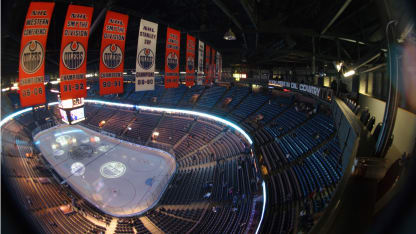
© Tim Smith/Getty Images
Badly dented because of countless butt ends from the sticks of players passing by on the way to the ice, it displayed stickers representing every playoff win in the history of the organization.
"I don't think the first dent was on purpose, but many more followed," former Oilers captain Mark Messier said. "It was a benchmark, a way for us to visually see where we stood as the playoffs went along. Every time we won a game, we put a sticker up on the door. We had to get 16 stickers to win the Stanley Cup and it became more of a ritual thing than anything. Then it became a good-luck thing, and one thing led to another, and then it was a superstitious thing around that door and it became part of the folklore."
The door is still in the Oilers dressing room, but following renovations in 2007 was moved into a hallway leading to the players' lounge, out of sight from visitors. It is expected to accompany the Oilers to their new downtown arena, Rogers Place, next season.
The statue of former Oilers legend Wayne Gretzky, which adorns the front steps of Rexall Place, also will be moved to Rogers Place, along with numerous other pieces of memorabilia.
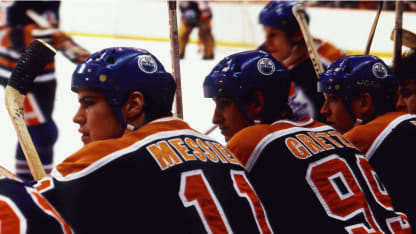
© Steve Babineau/Getty Images
Rogers Place will be the centerpiece of a new arena neighborhood, branded the "Ice District" in downtown Edmonton, and will seat 18,641 for hockey, an improvement from Rexall Place's capacity of 16,839.
Rogers Place cost an estimated $480 million (Canadian) to construct and is expected to be one of the premier arenas in the NHL. The state-of-the-art facility is scheduled to open in September, in time for the 2016-17 NHL season.
"Like anything in life, change is part of life," Gretzky said. "When the Montreal Forum went down and the Maple Leaf Gardens went down, it proved anything is possible. Moving into a new era with some unreal and great memories of Rexall Place, and now moving into [the] new arena, hopefully [the Oilers] can make some new and wonderful memories."
In 1974, Northlands Coliseum was constructed for $17.3 million (Canadian). The Oilers will play their final game in the building on April 6 against the Vancouver Canucks.
Considered "The House Wayne Gretzky Built," Rexall Place was the site of some of the greatest moments in NHL history.
"It was one of the great places to ever play," Gretzky said. "The atmosphere was always wonderful. When you have a great team, it is always wonderful to go to the rink each and every day. There's no question, we had a reputation of having the best ice in hockey and it was always good ice, which suited our team perfectly. The fans were always good to us. I think, in a lot of ways, our team played hard and was good to the fans, so it was a perfect marriage."
The early years
"I remember seeing it built because I am from Edmonton. My first training camp was at the old Edmonton Gardens, which most people won't even remember. It's fun to see the old buildings, but it also sad to see them go." -- former Oilers goaltender Grant Fuhr
Northlands Coliseum opened in November 1974 and housed the Edmonton Oilers of the World Hockey Association. In their inaugural season, they were known as the Alberta Oilers.
The arena replaced Edmonton Gardens, located across the street. At the time of its debut, the arena was considered one of the most modern indoor sporting facilities in North America. It was the first arena in Canada with a scoreboard hanging above center ice with an electronic message board.
Along with the NHL and WHA, Rexall Place was a venue for the 1981 and 1984 Canada Cup tournaments, and the 1995 and 2012 IIHF World Junior Hockey Championships.
"Growing up here, I used to go to the Edmonton Gardens and watch the teams play there," Messier said. "I remember riding the bus when I was 10 years old to go see the Edmonton Oil Kings (Western Canada Hockey League) and then the Oilers came, and who would have ever thought Edmonton could get an NHL franchise and build a building of this stature?
"This became everybody's living room, this became everybody's cathedral. This was a place to get to, it all gave us a place to aspire to. As an Edmonton kid, coming here and watching games, watching Gordie Howe in the WHA and then being able to come here and play in this building and play for the Oilers, it was unimaginable."
Edmonton joined the NHL in 1979 with three other WHA franchises. Gretzky was the Oilers' cornerstone, acquired the previous year from the Indianapolis Racers of the WHA by owner Peter Pocklington.
Glen Sather was the Oilers coach and general manager and acquired Messier, Kevin Lowe, Jari Kurri, Paul Coffey, Glenn Anderson, Andy Moog and Grant Fuhr, who would form the nucleus of a hockey dynasty.
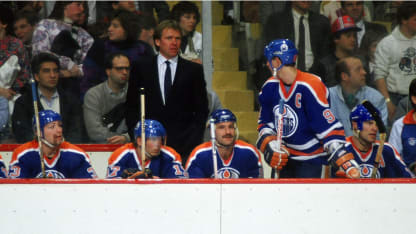
© Steve Babineau/Getty Images
"To me, the most important thing we can do as a league and as an organization is preserve the history and integrity of what has gone on here," Messier said. "That helps cement the folklore of what has gone on here."
The Oilers' coming-out party was against the Montreal Canadiens in the first round of the 1981 Stanley Cup Playoffs. Edmonton swept the best-of-5 series with Moog, a relative unknown, starting in goal.
The Oilers won the first two games in Montreal and returned to Northlands Coliseum for Game 3, where a raucous crowd greeted them.
"I had very little experience to that point, but the boys in the locker room said it was the first time they heard the crowd getting loud before we went out for the warmup," Moog said. "The fans were there early, they were boisterous and loud, and they were letting us know they expected us to win. That was kind of cool. I was so naive that I didn't realize that wasn't normal."
The Oilers defeated the Canadiens in Game 3 to win their first NHL playoff series, and the crowd at Northlands celebrated as if they had won the Stanley Cup.
"When we came back, up two games, the city was excited," said Lowe, a defenseman. "When we were getting ready for the third game, we heard this weird sound that we had never heard before, and it was the fans stamping on the floor, and we could hear it inside the dressing room."
The Oilers lost to the New York Islanders in the next round, which became the opening chapter in a legendary rivalry.
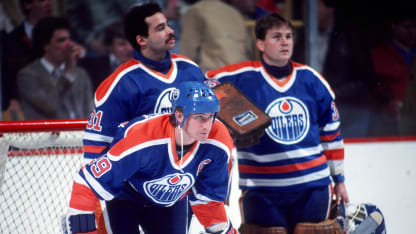
© Steve Babineau/Getty Images
The Islanders were defending Stanley Cup champions and went on to win three more in a row before being dethroned by the Oilers in 1984.
"In 1981, I remember it, the Oilers weren't quite there yet, but we knew a little bit about them with their speed and, of course, with Gretzky," former Islanders forward Butch Goring said. "The thing about this particular building is that the ice was always fast and we knew it was going to be a fast game. But we were a very confident team, we had just come off our first Stanley Cup and that got us over the hump, sort of, in not worrying about our skill level, we pretty much proved to ourselves that we were a good hockey team and we were having another good season.
"We didn't think a whole lot about that Edmonton team, but we had a lot of respect for them and we knew what they were all about, particularly Gretzky."
A new dynasty
"I'll always remember those great series between the Oilers and the Islanders back in the '80s. The quote I always remember is, Wayne Gretzky talking about realizing what it took to win the Stanley Cup when he walked by the Islanders locker room and to see what those guys gave up mentally and physically and how beat up they were. Something like that, from a player like that, resonates for a long time. Even for a guy that didn't get to see that, you hear about that today. That was pretty special hockey, so many great players and tremendous teams and two dynasties, one that followed the other." --Islanders captain John Tavares
Gretzky's tale of how the Oilers came to understand the sacrifices it took to win the Stanley Cup with a glimpse into the Islanders dressing room following Edmonton's Game 4 defeat in the 1983 Final reverberates.
Rexall Place played host to 20 Stanley Cup Final games, and the Oilers won 15. They won 87 of 129 playoff games at Rexall Place and raised the Stanley Cup at home on four occasions.
"Every time I come back to Edmonton or even see Edmonton come to the Island, it just brings back a flurry of memories," Goring said. "This is an old-time building, and the new buildings are beautiful, but they don't create the same atmosphere, the same loudness, and they don't have the same viewing angles that the old buildings do. So I walk in here right away and I see the angle of the seats and the proximity of the seats to the ice level and you know it's going to be loud in here."
The Oilers and Islanders met in the Stanley Cup Final again in 1984. This time the Oilers prevailed, and in the 2-3-2 series format adopted by the NHL for the first time, Edmonton was able to win the Stanley Cup on home ice in Game 5.
"When that game finished and we won it, I remember the fans coming over the glass and [being] on the ice and they were almost tripping you down and things like that," former right wing Jari Kurri said. "I was a little shocked wondering what was going on, because you don't expect something like that. But then you realize how much it meant to the city and the fans and the teammates.
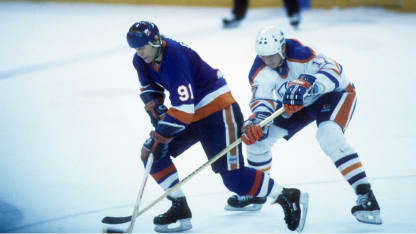
© B Bennett/Getty Images
"Coming over from Europe, I didn't have a clue about what it was like to win a Stanley Cup, and so it was great to be a part of that. Having 17,000 people at a hockey game, I wasn't used to that back home. That's something you have to get used to. You knew hockey was big in Canada and the NHL was big, but those things are something you really have to experience to appreciate it."
The Oilers played in the Stanley Cup Final seven times, winning five. The first championship put the city, the team and the arena on the map.
"The first Stanley Cup, winning that Cup and being in that arena, the atmosphere was overwhelming," Gretzky said. "I remember that like it was yesterday."
Competitive advantage
"The ice was second to none here. It was hard, it was fast and it allowed certain players to be able to play the game they were suited for. For me, it was great because that's the way my game was built." -- former Oilers forward Todd Marchant
Following their win against the Islanders in the 1984 Stanley Cup Final, the Oilers were considered the class of the NHL. They returned to the Stanley Cup Final in 1985 against the Philadelphia Flyers and won the series in five games.
The Oilers won the Stanley Cup again in 1987 and 1988, clinching their series at home against the Flyers and Boston Bruins.
The Oilers were a team built on speed and skill, and had a distinct advantage playing at Northlands Coliseum, generally considered to have the best ice in the NHL.
"In this building, as far as what I remember, was how great the ice was, how fantastically smooth it was," said Anderson, a right wing. "When you went into other buildings, like Los Angeles, Chicago or New York, the ice was never consistent and you never knew what you were getting. When you played here in Edmonton, the ice was consistently good and consistently fast.
"Maybe some of the teams weren't prepared for that, and we always had a lot of great skaters on our team and that was a big advantage. I remember when the other teams, when they watched us practice, they were intimidated because the ice was so good and we were so fast."
Dan Craig was in charge of the ice crew in Edmonton during the early years, and he was meticulous in his planning and preparation, knowing how important the quality of the ice was to the Oilers' success.
"The puck always ran really well," Craig said. "So if you always watched the back passes from Gretzky to Kurri, the puck is traveling 25 feet, and if you tried to do that in Boston, it's traveling 8. And if you watched Wayne [on the road] and if he wasn't comfortable with his passes, you could tell, because he wasn't trying those long passes that he would try here. The players told us when the ice was really good, and we just took all the numbers from all the charts from that particular time and we would make sure we would try to duplicate them every single day."
Craig is now the NHL manager of facilities operations and oversees the ice for every team in the League. He also supervises the rink builds for the League's outdoor games, including the Winter Classic, Stadium Series and Heritage Classic.
His work in Edmonton helped the Oilers become a dynamic offensive team, which revolutionized the game.
"The ice was always great," former Oilers goaltender and coach Ron Low said, "and then you put the people you had at that time on your hockey club, we had Glenn Anderson, Paul Coffey and Mark Messier. Gretzky wasn't the greatest skater, but he saw the ice well enough for the skater on his right side [Jari Kurri] to score 100 goals. The ice was terrific and it made for excitement in the building too."
Memorable moments
Rexall Place was where many NHL records were set, a majority of them by Gretzky, who scored 583 regular-season goals and 122 playoff goals with the Oilers.
One of the first records Gretzky set was on Dec. 30, 1981, when he scored five goals against the Flyers to reach 50 goals in 39 games. Gretzky broke the mark of 50 in 50 set by Canadiens legend Maurice Richard and Islanders forward Mike Bossy.

© Bruce Bennett/Getty Images
Gretzky's fifth goal that night was scored into an empty net with three seconds remaining, which became one of the most iconic moments in Rexall Place history.
"It was a surreal night," Lowe said. "I was living with Wayne at the time and he had told his dad [Walter Gretzky] that he probably should fly to Vancouver, because we were playing Vancouver the next game. He said to go to Vancouver and that he probably wouldn't do it there, but to start following him from that point. Then he phoned his dad after the game from a pay phone in the hallway to tell him not to bother coming, because he had done it, it was over."
Following the dynasty years, the Oilers struggled to keep pace in a non-salary cap league as a small-market team. The Oilers rebranded themselves by trading veteran star players for young, upcoming talent.
The Oilers missed the playoffs for four years starting in 1993 but returned in 1997 as an underdog and generated a new form of excitement at the renamed Edmonton Coliseum.
"I'm very proud that our team made the playoffs six straight years in my last six years here, sometimes playing teams that were paying $30 [million]-to-$50 million more than our team was making," Weight said. "It was special, and to win two of those six series was special. For the fans here, it was an incredible feeling."
One of the most memorable nights for the new-look Oilers was on April 20, 1997, in Game 3 of the Western Conference Quarterfinals against the Dallas Stars.
Down 3-0 in the third period, fans started making their way toward the exits with five minutes left. The Stars had not conceded a third-period lead all season and it seemed unlikely to happen that night, when the Oilers had been thoroughly outplayed.
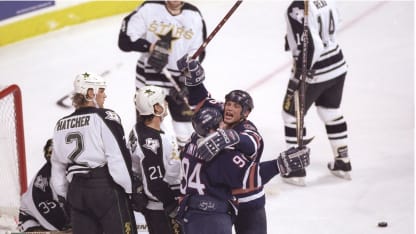
© Stephen Dunn
The building was emptying when Weight scored to make it 3-1 with 4:00 remaining. They were in the parking lot when Andrei Kovalenko scored to make it 3-2 with 2:16 remaining. And by the time they started their cars, Mike Grier had tied the game 3-3, creating a mass rush back into the arena.
"I remember people panicking to get back in, and I think they all got back in," Weight said. "It was a smart move by the security guys at the doors letting them back in.
"What I remember mostly about it, was during the overtime intermission, we could barely hear [coach] Ronnie Low talk. I think everyone got back in their seats and they were banging on the floor and it felt like the ceiling was going to come down. It was just like being on the bench, and the guys were looking around thinking, 'We better not lose this game now. We've shook up the world here, we better win this game,' and it was fitting that Kelly [Buchberger] was able to do it."
Buchberger scored the overtime winner and the Oilers went on to win the series on an overtime goal by Todd Marchant in Game 7 at Dallas.
It was the first time in five years the Oilers won a playoff series.
"That was the culmination, and we rode the wave for three or four years, in a tough time, with the Canadian dollar being where it was [$0.65 U.S.] and there was no salary cap," Weight said. "It was a big challenge for our hockey club, and that was the most proud thing, that we were able to win a couple of series and make the playoffs."
Another Cup run
"That was pretty special. All those young guys like Taylor Hall and Jordan Eberle coming in would ask about it, and I would tell them they hadn't seen anything in this building until they experienced the playoffs." -- former Oilers captain Shawn Horcoff
The introduction of the NHL salary cap in 2005 leveled the playing field between large-market and small-market teams, which proved beneficial to the Oilers.
Prior to the 2005-2006 season, the Oilers traded for defenseman Chris Pronger and forward Michael Peca, increasing expectations for fans and the organization. Things came together for Edmonton after acquiring goaltender Dwayne Roloson, leading to an unexpected playoff run and another trip to the Stanley Cup Final, where the Oilers lost to the Carolina Hurricanes.
"There was nothing like that 2006 run for me from start to finish, beginning with that first playoff game against Detroit," former forward Ryan Smyth said. "I remember the steak being thrown on the ice in the first round [to combat Detroit's octopus], to Game 6 in the Stanley Cup Final against Carolina. It was so electrifying, it just ran through your body. There was a lot of energy in us and the fans gave us that extra edge when we came here and felt drained."
The Oilers upset the Detroit Red Wings in the first round, winning the series in six games, and then defeated the San Jose Sharks and Anaheim Ducks to make it to the Stanley Cup Final.
"The city just lived, breathed, and died it for the whole two months there, and there was probably even more excitement because it wasn't expected," Horcoff said. "Back in the '80s, they definitely expected to go, but for us, when we won the first round it was almost like we won the Cup, because we had just beaten the No. 1 seed. It exploded from there and then it just snowballed into this thing that was just amazing. To be a part of that in this building was really something special."
In the Final, the Oilers lost the first two games in Carolina and Roloson sustained a series-ending knee injury. The Oilers returned to Edmonton for Game 3 and were able to get back into the series with a 2-1 win, bolstered by a passionate crowd.
"You could feel the building in the locker room and you could feel the noise before we were going to go out for warmup," Horcoff said. "Then when we got out there for the game and skated out on the ice through that oil derrick, I just remember how deafening loud it was. I think they were setting records for loud sporting venues and people were tailgating, which doesn't happen in hockey."
The Oilers fell behind 3-1 in the best-of-7 series, but a shorthanded overtime goal in Game 5 by Fernando Pisani brought the series back to Edmonton, setting the stage for one of the most dominant performances for the franchise in history of the Stanley Cup Final.
"I'd say that Cup run in 2006, the building was the loudest ever," said Lowe, who was general manager at the time. "It was a carryover from that new demographic of fan that we had in the '90s. We created a whole new fan base. The '06 run was a chance for a whole new group of fans to have their time and be proud of their team and not have to listen to their parents or grandparents talk about the '80s."
Game 6 of the 2006 Stanley Cup Final was the last playoff game at Rexall Place. The Oilers won 4-0 and looked poised to win their sixth Stanley Cup championship. But Carolina recovered from the loss and won Game 7.
"There were so many great moments in here," Smyth said. "But for me, Game 6 in the 2006 Stanley Cup Final, that's a moment that stands out for me. That was probably our best game of the playoffs. The fans were electric, the stadium was so loud, and I thought the roof was going to come off."
Rebuilding
"It's always been a special place to come and play, especially during the Battle of Alberta. It's a unique building, it's different than the other ones; it has that character and stuff. I'll miss it, it's been fun; there have been some good games and some tough games here." --former Calgary Flames forward Jarome Iginla
Edmonton has gone through 10 lean years as the Oilers go through a rebuilding phase. However, among the recent struggles, there have been special nights at Rexall Place.
Sam Gagner tied an Oilers record, held by Gretzky and Coffey, with eight points in one game (four goals, four assists) on Feb. 2, 2012 in an 8-4 win against the Chicago Blackhawks. Gagner was awarded all three stars of the game, a first in Oilers history.
Smyth, who returned to the Oilers in 2011 after being traded in 2007, played his final game on April 13, 2014 at Rexall Place. Smyth was named captain for the night and received a lengthy standing ovation at the end of the game.
"It really felt like I knew every single fan, that's how appreciative I was that they stayed around, and I was very humbled by that," Smyth said. "It was a very emotional time for sure, but it honestly felt like I knew every single fan. Still to this day, I run into people on the street that said they were at my last game, and I'm very appreciative of that."
Rexall Place left a lasting impression on the NHL and the city of Edmonton. The arena will house non-hockey related events, but a decision on the eventual fate of the building has yet to be determined.
"There is a lot of history here," Smyth said. "Obviously you look up in the rafters and you see those banners that are part of the city, not just part of the Oilers, but the history of this city. This is more than just a hockey rink. There is history with the [WHA] Oilers and the guys that paved the way for us. I'm going to miss it."
Along with all the memorable games, there have been special events in the arena, which have left a lasting legacy.
There have been nine banner-raising ceremonies for members of the Hockey Hall of Fame, and in October 2014, the Oilers held a special 30th anniversary of their first Stanley Cup championship team.
More than 150 former players are expected to attend the closing ceremony for Rexall Place on April 6.
"I'm going to miss this place," Horcoff said. "No rinks smell like these ones anymore; they smell like hockey. This rink, you come in and you smell the ice and it has the wide bowels underneath the stands, and it's just different.
"This rink is just pure hockey."





